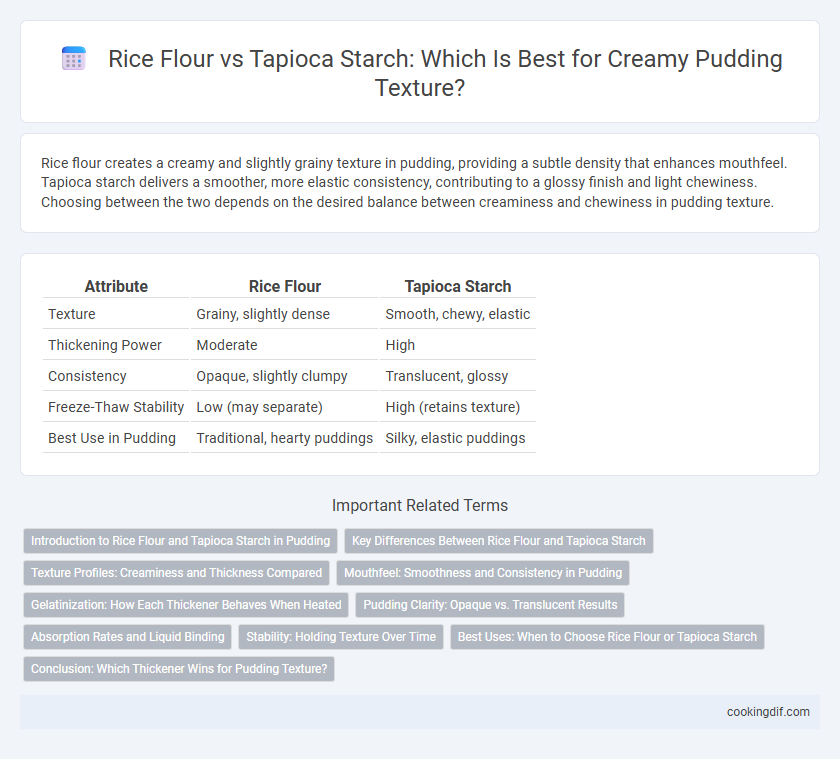Rice flour creates a creamy and slightly grainy texture in pudding, providing a subtle density that enhances mouthfeel. Tapioca starch delivers a smoother, more elastic consistency, contributing to a glossy finish and light chewiness. Choosing between the two depends on the desired balance between creaminess and chewiness in pudding texture.
Table of Comparison
| Attribute | Rice Flour | Tapioca Starch |
|---|---|---|
| Texture | Grainy, slightly dense | Smooth, chewy, elastic |
| Thickening Power | Moderate | High |
| Consistency | Opaque, slightly clumpy | Translucent, glossy |
| Freeze-Thaw Stability | Low (may separate) | High (retains texture) |
| Best Use in Pudding | Traditional, hearty puddings | Silky, elastic puddings |
Introduction to Rice Flour and Tapioca Starch in Pudding
Rice flour provides a smooth and slightly grainy texture to pudding, enhancing its body without making it overly chewy. Tapioca starch creates a glossy, elastic consistency that gives pudding a chewy and creamy mouthfeel. Using rice flour results in a denser pudding texture, while tapioca starch delivers a light, stretchy quality preferred in traditional Asian desserts.
Key Differences Between Rice Flour and Tapioca Starch
Rice flour provides a slightly gritty and denser texture to pudding, offering a mild, nutty flavor that complements creamy desserts. Tapioca starch creates a smoother, more elastic, and glossy pudding with superior thickening power, resulting in a light and chewy consistency. The key differences between rice flour and tapioca starch lie in their gelatinization temperatures, water absorption rates, and the final pudding texture--rice flour thickens at higher temperatures and yields a grainier finish, while tapioca starch thickens quickly at lower temperatures, producing a clearer and more cohesive pudding texture.
Texture Profiles: Creaminess and Thickness Compared
Rice flour imparts a smooth, slightly grainy texture to pudding, enhancing creaminess with a mild thickness that feels comforting on the palate. Tapioca starch creates a glossy, elastic consistency, providing a chewy, thick texture that gives pudding a unique bounce and richness. Comparing texture profiles, rice flour offers gentle creaminess and moderate thickness, while tapioca starch delivers pronounced thickness with a distinctive chewy mouthfeel.
Mouthfeel: Smoothness and Consistency in Pudding
Rice flour imparts a slightly grainy texture to pudding, resulting in a thicker but less smooth mouthfeel compared to tapioca starch. Tapioca starch creates a more elastic, glossy, and consistently smooth pudding, enhancing the creamy sensation with a delicate chewiness. The choice between rice flour and tapioca starch directly influences the pudding's texture, affecting overall enjoyment by altering smoothness and consistency.
Gelatinization: How Each Thickener Behaves When Heated
Rice flour gelatinizes by absorbing water and swelling between 62-72degC, creating a smooth, slightly creamy texture ideal for dense puddings. Tapioca starch gelatinizes at a higher temperature range of 52-65degC, forming a glossy, elastic gel that gives puddings a chewy, stretchy consistency. The differences in gelatinization temperatures and water absorption influence the final pudding texture, with rice flour producing a thicker, less elastic finish and tapioca starch yielding a lighter, more transparent set.
Pudding Clarity: Opaque vs. Translucent Results
Rice flour creates a creamy, opaque pudding texture due to its fine starch granules that absorb more liquid and swell substantially during cooking. Tapioca starch yields a translucent, glossy pudding with a chewy, gel-like consistency as its larger starch molecules form a clear gel upon hydration and heating. Choosing rice flour results in a denser, milkier appearance, while tapioca starch enhances pudding clarity and a smoother, more elastic mouthfeel.
Absorption Rates and Liquid Binding
Rice flour exhibits a moderate absorption rate, resulting in a pudding texture that is slightly creamy but firmer compared to tapioca starch. Tapioca starch has a higher liquid binding capacity, producing a smoother, more elastic pudding with a glossy finish. The choice between rice flour and tapioca starch significantly impacts the pudding's mouthfeel and moisture retention, making tapioca starch ideal for a silkier consistency.
Stability: Holding Texture Over Time
Rice flour provides a smooth and creamy texture in pudding with moderate stability, maintaining its consistency for a reasonable period. Tapioca starch excels in stability, enhancing the pudding's ability to hold its gel-like structure over time without syneresis or breakdown. Choosing tapioca starch ensures longer-lasting firmness and resistance to texture degradation during storage.
Best Uses: When to Choose Rice Flour or Tapioca Starch
Rice flour provides a slightly grainy texture and is ideal for creamy rice puddings or thickening sauces where a mild, subtle flavor is desired. Tapioca starch creates a smooth, chewy consistency perfect for glossy, elastic puddings like bubble tea or cassava-based desserts. Choose rice flour for dense, hearty textures and tapioca starch for light, stretchy results in pudding recipes.
Conclusion: Which Thickener Wins for Pudding Texture?
Rice flour creates a denser, creamier pudding with a slightly grainy texture, ideal for traditional, richer recipes. Tapioca starch produces a smoother, more elastic consistency with a glossy finish, enhancing the pudding's lightness and chewiness. For a silky, tender pudding texture, tapioca starch is the winning thickener, while rice flour suits those preferring a hearty, substantial mouthfeel.
Rice flour vs Tapioca starch for texture Infographic

 cookingdif.com
cookingdif.com